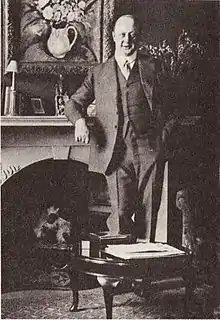Albrecht Graf von Bernstorff (1890-1945)
Albrecht Theodor Andreas Graf von Bernstorff (German pronunciation: [ˈalbʁɛçt ˈɡʁaːf fɔn ˈbɛʁnsˌtɔʁf], ![]() audio ; 6 March 1890 – 24 April 1945) was a German diplomat and member of the resistance to Nazi Germany.
audio ; 6 March 1890 – 24 April 1945) was a German diplomat and member of the resistance to Nazi Germany.
Albrecht Graf von Bernstorff | |
|---|---|
 | |
| Born | 6 March 1890 Berlin, Germany |
| Died | 24 April 1945 (aged 55) Lehrterstraße Prison, Berlin |
| Cause of death | Execution |
| Nationality | German |
| Occupation | Diplomat |
| Known for | Opposing the Nazi government and taking part in the July 20th Plot |
| Parent(s) | Andreas von Bernstorff and Augusta von Hottinger |
Biography
Albrecht Bernstorff was the oldest of Andreas von Bernstorff's and Augusta von Hottinger's five children. The Bernstorff family was known for its eminent statesmen and diplomats.[1] He grew up in Berlin and on the family estate Stintenburg, and embarked upon a short agricultural apprenticeship before being chosen for a Rhodes Scholarship for the year 1909.[2] He studied at Trinity College, Oxford from 1909 to 1911. During his stay at Oxford, he co-founded the Hanover Club, an Anglo-German student debating society, and co-authored a small booklet containing advice for future German students.[3] He completed his degree at Kiel University, following a short stint of voluntary military service.[4]
After being admitted to diplomatic service in 1914, Bernstorff spent the next three years at the German Embassy in Vienna, from where he was recalled in 1917. He was later involved in the Inter-Allied Rhineland High Commission. He then took a one year leave from his diplomatic career to gain experience in the banking business, joining the bank Delbrück, Schickler & Co. in Berlin.[5] Bernstorff worked at the German Embassy in London from 1923 to 1933 and was considered an important figure in British-German relations.[6] He was forced into retirement for his open opposition to the Nazi government. After returning to Germany, he joined the Jewish bank A.E. Wassermann, which was engaged in transferring Jewish assets abroad.[7] In 1940, he was sent to Dachau concentration camp but was released a few months later. Through Adam von Trott zu Solz, he had established relations with both the Solf Circle and the Kreisau Circle and used his wide range of contacts in Germany and abroad to help connect resistance members to influential circles which helped lay preparation for the 20 July plot.[8] In 1943, he was imprisoned again until his execution, in late April 1945.[9]
References
- Opitz, Eckardt (2011). Die Bernstorffs: Eine europäische Familie. Heide: Verlag Boyens und Co. ISBN 3804209920.
- Hansen, Knut (1996). Albrecht Graf von Bernstorff: Diplomat und Bankier zwischen Kaiserreich und Nationalsozialismus. Frankfurt: Peter Lang. p. 25. ISBN 3631491484.
- Hansen, Knut (1996). Albrecht Graf von Bernstorff: Diplomat und Bankier zwischen Kaiserreich und Nationalsozialismus. Frankfurt: Peter Lang. pp. 26, 28. ISBN 3631491484.
- Opitz, Eckardt (2011). Die Bernstorffs: Eine europäische Familie. Heide: Verlag Boyens und Co. p. 82. ISBN 3804209920.
- Opitz, Eckardt (2011). Die Bernstorffs: Eine europäische Familie. Heide: Verlag Boyens und Co. p. 84. ISBN 3804209920.
- "Leitbild und Erbe - Stiftung 20. Juli 1944". www.stiftung-20-juli-1944.de (in German). Retrieved 2020-04-21.
- Hansen, Knut (1996). Albrecht Graf von Bernstorff: Diplomat und Bankier zwischen Kaiserreich und Nationalsozialismus. Frankfurt: Peter Lang. p. 214. ISBN 3631491484.
- Hansen, Knut (1996). Albrecht Graf von Bernstorff: Diplomat und Bankier zwischen Kaiserreich und Nationalsozialismus. Frankfurt: Peter Lang. pp. 226, 227–233. ISBN 3631491484.
- "Albrecht Graf von Bernstorff - Diplomat und NS-Widerstandskämpfer". Deutschlandfunk (in German). Retrieved 2020-04-21.